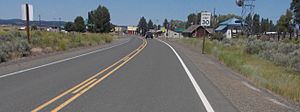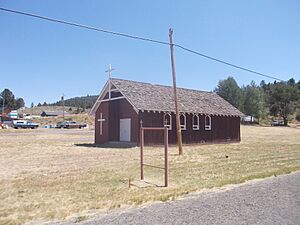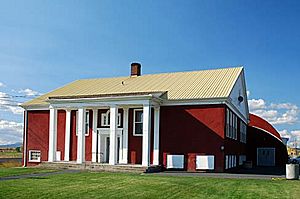Seneca, Oregon facts for kids
Quick facts for kids
Seneca, Oregon
|
|
|---|---|

Seneca along U.S. Route 395
|
|

Location in Oregon
|
|
| Country | United States |
| State | Oregon |
| County | Grant |
| Incorporated | 1970 |
| Area | |
| • Total | 0.80 sq mi (2.06 km2) |
| • Land | 0.80 sq mi (2.06 km2) |
| • Water | 0.00 sq mi (0.00 km2) |
| Elevation | 4,675 ft (1,425 m) |
| Population
(2020)
|
|
| • Total | 165 |
| • Density | 207.55/sq mi (80.14/km2) |
| Time zone | UTC-8 (Pacific) |
| • Summer (DST) | UTC-7 (Pacific) |
| ZIP code |
97873
|
| Area code(s) | 541 |
| FIPS code | 41-66200 |
| GNIS feature ID | 2411867 |
Seneca is a small city in Grant County, Oregon, in the United States. It's nestled in the Blue Mountains, about 23 miles (37 km) south of Canyon City. You can find it right on U.S. Route 395, next to the huge Malheur National Forest. In 2010, about 199 people lived there.
Contents
History of Seneca
The town of Seneca got its start with a post office in 1895. It was named by the postmaster, Minnie Southworth, after her brother-in-law, Seneca Smith. He was a well-known judge from Portland.
Growth of the Lumber Industry
Early settlers moved into the valley in the late 1800s. But Seneca really started to grow in 1929. This was when it became the northern end of the Oregon and Northwestern Railroad. This railroad was owned by the Edward Hines Lumber Company. It stretched south all the way to Burns.
At that time, large amounts of Ponderosa Pine logs began to be shipped from Seneca. These logs came from the surrounding national forest. They were sent to the Hines sawmill in Hines. The company built a planing mill and railroad shops in Seneca. This made Seneca mostly a "company town." This means the town was largely controlled by the lumber company.
In 1940, Seneca's population reached 275 people.
Decline and Incorporation
Logging in the area began to slow down in the 1970s. The Hines company stopped running its lumber mills and railroad in 1984.
As the lumber company's control lessened, the town officially became a city in 1970. According to the 1980 census, Seneca's population was 285. By 2007, the estimated population was 270.
Geography of Seneca
According to the United States Census Bureau, the city covers a total area of 0.80 square miles (2.07 km2). All of this area is land.
Seneca is located where Bear Creek and the Silvies River meet. It sits in Bear Valley, at the northern edge of the Great Basin.
Climate in Seneca
Seneca has a climate that is a mix of humid continental and semi-arid. This means summers have warm days, but nights are cool or cold all year round.
Seneca experiences the coolest weather in Grant County. It holds the record for the coldest official temperature ever recorded in Oregon: a very chilly −54 °F (−48 °C) in 1933!
| Climate data for Seneca, Oregon, 1991–2020 normals, extremes 1912–2021 | |||||||||||||
|---|---|---|---|---|---|---|---|---|---|---|---|---|---|
| Month | Jan | Feb | Mar | Apr | May | Jun | Jul | Aug | Sep | Oct | Nov | Dec | Year |
| Record high °F (°C) | 58 (14) |
64 (18) |
74 (23) |
83 (28) |
89 (32) |
104 (40) |
104 (40) |
104 (40) |
100 (38) |
90 (32) |
72 (22) |
59 (15) |
104 (40) |
| Mean maximum °F (°C) | 47.4 (8.6) |
52.1 (11.2) |
61.9 (16.6) |
71.2 (21.8) |
80.1 (26.7) |
87.1 (30.6) |
94.3 (34.6) |
93.7 (34.3) |
89.6 (32.0) |
78.0 (25.6) |
61.9 (16.6) |
47.5 (8.6) |
96.0 (35.6) |
| Mean daily maximum °F (°C) | 35.9 (2.2) |
40.0 (4.4) |
46.3 (7.9) |
52.6 (11.4) |
61.8 (16.6) |
70.0 (21.1) |
82.1 (27.8) |
81.9 (27.7) |
73.4 (23.0) |
59.6 (15.3) |
44.4 (6.9) |
35.7 (2.1) |
57.0 (13.9) |
| Daily mean °F (°C) | 23.5 (−4.7) |
26.8 (−2.9) |
33.1 (0.6) |
38.8 (3.8) |
46.8 (8.2) |
53.1 (11.7) |
60.3 (15.7) |
58.4 (14.7) |
50.3 (10.2) |
40.5 (4.7) |
30.8 (−0.7) |
23.4 (−4.8) |
40.5 (4.7) |
| Mean daily minimum °F (°C) | 11.1 (−11.6) |
13.6 (−10.2) |
19.9 (−6.7) |
25.1 (−3.8) |
31.7 (−0.2) |
36.2 (2.3) |
38.5 (3.6) |
34.9 (1.6) |
27.3 (−2.6) |
21.4 (−5.9) |
17.1 (−8.3) |
11.1 (−11.6) |
24.0 (−4.4) |
| Mean minimum °F (°C) | −11.5 (−24.2) |
−4.9 (−20.5) |
4.1 (−15.5) |
14.6 (−9.7) |
19.3 (−7.1) |
26.1 (−3.3) |
29.4 (−1.4) |
24.9 (−3.9) |
16.1 (−8.8) |
7.1 (−13.8) |
−2.9 (−19.4) |
−12.5 (−24.7) |
−20.2 (−29.0) |
| Record low °F (°C) | −43 (−42) |
−54 (−48) |
−26 (−32) |
2 (−17) |
6 (−14) |
16 (−9) |
19 (−7) |
13 (−11) |
1 (−17) |
−11 (−24) |
−31 (−35) |
−41 (−41) |
−54 (−48) |
| Average precipitation inches (mm) | 1.58 (40) |
1.01 (26) |
1.23 (31) |
1.18 (30) |
1.71 (43) |
1.19 (30) |
0.53 (13) |
0.38 (9.7) |
0.53 (13) |
1.07 (27) |
1.44 (37) |
1.82 (46) |
13.67 (345.7) |
| Average snowfall inches (cm) | 11.2 (28) |
7.8 (20) |
6.3 (16) |
1.4 (3.6) |
0.4 (1.0) |
0.0 (0.0) |
0.0 (0.0) |
0.0 (0.0) |
0.0 (0.0) |
0.8 (2.0) |
7.4 (19) |
23.0 (58) |
58.3 (147.6) |
| Average precipitation days (≥ 0.01 in) | 11.8 | 9.9 | 11.0 | 10.6 | 9.5 | 7.2 | 3.8 | 3.1 | 4.3 | 7.6 | 11.8 | 12.7 | 103.3 |
| Average snowy days (≥ 0.1 in) | 6.1 | 4.3 | 3.0 | 1.2 | 0.3 | 0.0 | 0.0 | 0.0 | 0.0 | 0.5 | 3.5 | 7.4 | 26.3 |
| Source 1: NOAA (snow/snow days 1981–2010) | |||||||||||||
| Source 2: XMACIS2 | |||||||||||||
People Living in Seneca
| Historical population | |||
|---|---|---|---|
| Census | Pop. | %± | |
| 1980 | 285 | — | |
| 1990 | 191 | −33.0% | |
| 2000 | 223 | 16.8% | |
| 2010 | 199 | −10.8% | |
| 2020 | 165 | −17.1% | |
| U.S. Decennial Census | |||
2010 Population Count
In 2010, the census showed that 199 people lived in Seneca. These people made up 95 households, with 60 of them being families. The city had about 248.8 people per square mile.
Most of the people living in Seneca (99.0%) were White. A small number (0.5%) were African American, and 0.5% were from two or more races. About 1.0% of the population identified as Hispanic or Latino.
Households and Families
Out of the 95 households:
- 21.1% had children under 18 living with them.
- 51.6% were married couples living together.
- 11.6% had a female head of household with no husband present.
- 36.8% were not families.
About 31.6% of all households were made up of individuals living alone. And 15.8% had someone living alone who was 65 years old or older. The average household had 2.09 people, and the average family had 2.53 people.
The average age of people in Seneca was 52.5 years.
- 16.1% of residents were under 18.
- 7.9% were between 18 and 24.
- 15% were between 25 and 44.
- 35.6% were between 45 and 64.
- 25.1% were 65 years or older.
The city had slightly more males (52.3%) than females (47.7%).
Economy of Seneca
The main ways people make a living in Seneca are through cattle ranching and producing timber (wood).
Education in Seneca
Seneca is part of the Grant County School District. This district used to be called the John Day School District.
Seneca School teaches students from K up to 5. After 5th grade, students go to Grant Union High School in John Day. Seneca School was built in the 1930s to educate the children of the Hines Lumber Company employees. In 2011, the school had 58 students.
See also
 In Spanish: Seneca (Oregón) para niños
In Spanish: Seneca (Oregón) para niños



